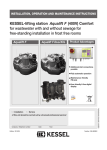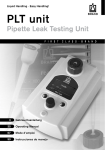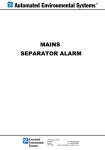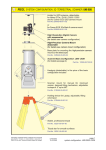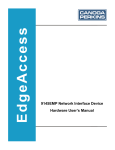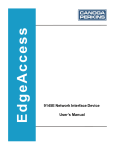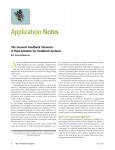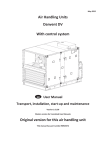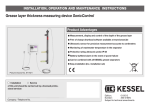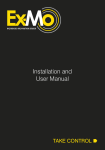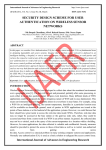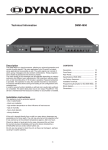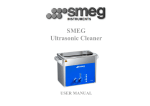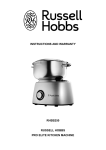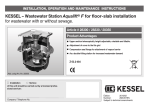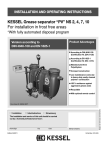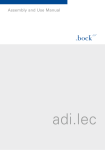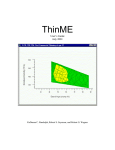Download F Duo/XXL SPF 550 KE
Transcript
INSTALLATION, OPERATING AND MAINTENANCE INSTRUCTIONS KESSEL-lifting station Aqualift 쏐F Duo/XXL SPF 550 KE for wastewater with and without faeces for free-standing installation in rooms protected from frost Aqualift 쏐F Duo/XXL SPF 550 KE Product advantages Drilling surfaces for further connections Fully automatic operation Maintenance-friendly PE-tank Installation Commissioning Subject to technical amend- User-friendly menu navigation via a 6-line display Instruction The installation and service of this unit should be carried out by a licensed professional servicer Name/Sign Edition 10/2010 Date Town Company - Telephone No. ID-Nr. 206-830EN 1. Safety information General safety precautions During installation, operation, maintenance or repairs to the system, please observe the accident prevention regulations, the applicable DIN and VDE standards and guidelines, and also the regulations of the local energy and supply companies. The systems may not be operated in explosive areas Electrical hazards This system contains electrical voltages and controls rotating mechanical parts. Non-observation of the operating instructions could lead to serious damage, injury or even fatal accidents. The system must be securely disconnected from the mains supply before commencing any work on it. The local master switch and the cut-outs must be turned off, i.e. switch the system to zero-potential and take precautions to ensure it cannot be switched on again. If only cut-outs are available, these must be switched off and a sign attached to prevent third parties from switching the main fuse on again. VDE 0100 applies to all electrical work on the system. The switchgear and the level control are under voltage and may not be opened. Only electricians may work on the electrical equipment. The term 'electrician' is defined in the VDE 0105. Steps must be taken to ensure that the electrical cables and all other electrical system parts are in a fully functional condition. If any parts are damaged, the system may not be operated and/or must be immediately shut down. ! Risk of burning fingers and hands The driving engine may become very hot during operation Risk of injury to fingers and hands The pumps are equipped with a closed impeller. Therefore work on the pump may only be carried out if the power supply has been disconnected and the rotating parts have stopped rotating. Take care on sharp edges during maintenance or repair work. Risk due to heavy weights The lifting system models with one pump weigh around 45 kg, and with two pumps around 84 kg. The systems may only be lifted or mounted by two persons with appropriate care wearing protective equipment (e.g. protective shoes). The pumps may only be removed slowly or placed in the pump flange opening by two persons (if suitable precautions to prevent slipping have been taken). 2 1. Safety information Health risk The wastewater system transports wastewater that contains faeces; in turn this faeces may contain harmful substances. Whenever working on the system, always ensure that there is no direct contact between the wastewater and/or soiled system parts and your eyes, mouth or skin. In the event of direct contact, clean the affected part of your body thoroughly and disinfect if necessary. It is also possible that the atmosphere in the tank may be harmful. Therefore before opening the cleaning aperture (or removing the pump) ensure that the respective room is adequately ventilated or provide for (forced) ventilation during the opening process. Noise pollution When the pump is operated, a noise level is created that may be a nuisance depending on how the pump is installed. If there are maximum noise level stipulations that need to be observed, appropriate measures need to be taken. The sound damping set from KESSEL may also be helpful here. Risk of explosion The inside of the tank is considered to be explosive within the meaning of EN 12050 because the biological digestive process may create flammable gases (hydrogen sulphide, methane gas). Therefore, when unscrewing the pump or the cleaning aperture lid or any other parts, ensure that the room is adequately ventilated or provide for (forced) ventilation during the opening process. Whilst the tank is open, it is forbidden to smoke or carry out any other activities in the respective room that could cause the gas to ignite (e.g. operation of electrical devices without encapsulated motors, metalworking etc.). 3 Table of contents 1. Safety information ...........................................................................................................Page 2 2. General 2.1 Application scope................................................................Page 5 2.2 Description of the system....................................................Page 5 3.1 Aqualift F Duo XXL ..............................................................Page 6 3.2 Information about safe use in explosive areas ................Page 7 4.1 Notes on the set-up location ...............................................Page 9 4.2 Connection of the pipes ......................................................Page 9 4.3 Level recording ....................................................................Page 10 5.1 General information .............................................................Page 11 5.2 Assembly of the switchgear ................................................Page 11 5.3 Installation, wiring................................................................Page 11 5.4 Checking the rotation direction of the pump ......................Page 11 5.5 Connection ..........................................................................Page 12 6.1 General information .............................................................Page 15 6.2 Pressure discharge pipes ....................................................Page 15 6.3 Description of the function ..................................................Page 15 6.4 Control unit operation..........................................................Page 16 7.1 Information about the pump................................................Page 19 7.2 Information about the backflow preventer ..........................Page 19 7.3 Information about the electrical switchgear ........................Page 20 8.1 General malfunctions .........................................................Page 21 8.2 Error messages ...................................................................Page 22 .............................................................................................Page 26 10. Warranty ...........................................................................................................Page 27 11. Declaration of conformity ...........................................................................................................Page 28 12. Handover record ...........................................................................................................Page 29 3. Technical data 4. Installation and assembly 5. Electrical connections 6. Commissioning 7. Inspection and maintenance 8. Malfunctions and troubleshooting 9. Spare parts and accessories 4 2. General 2.1 Application scope The lifting systems pump the wastewater (with and without faeces) that is collected below the drain and local back-up level into the sewers fully automatically in compliance with the stipulations of EN 12056. They may only be used for household wastewater, for example from detached homes and apartment buildings, commercial operations, hotels and restaurants, shops, hospitals, schools or other similar cases. If the incoming flow to the lifting system may not be interrupted during normal operation, the lifting system also needs to be equipped with a second pumping device with the same output level that can switch on automatically if required (double instead of single system). The KESSEL Aqualift® F lifting system is designed for freestanding installation in frost-protected rooms. The associated switchgear needs to be installed in a dry room protected from flooding and frost. The pressure lines must be designed to be at least DN 80, the ventilation lines at least DN 50. Abrasive media must be kept away from the pump impeller. The systems are suitable for permanent wastewater temperatures of up to 35°C. Brief (up to 10 minutes) incoming temperatures of maximum 60°C are allowed. 2.2 Description of the Aqualift F Duo XXL system 1993 mm ➅ ➁ DN 150 ➀ 1092 mm ➅ 391 mm ➄ ➆ ➆ ➃ ➇ 1923 mm ➀ Intake line DN 150 ➁ Pressure connection DN 100 ➂ Ventilation DN 100 ➃ Two wastewater pumps each with a 5 m connection line ➄ Sump made of polyethylene 5 ➇ ➅ Cleaning aperture ➆ Blocking device ➇ Check valve ➃ ➂ 3. Technical data 3.1 Aqualift F Duo XXL Models: • Aqualift F Duo XXL (double system) 3,3 kW with pressure discharge DN 100, • Aqualift F Duo XXL (double system) 4,2 kW with pressure discharge DN 100, • Aqualift F Duo XXL (double system) 5,6 kW with pressure discharge DN 100 Max. Förderhöhe H (m) Pumping capacity diagram Aqualift ® F Duo XXL 22 20 18 16 14 12 10 8 6 4 2 0 400 V 3,3 kW 400 V 4,0 kW 400 V 5,6 kW Q min nach DIN EN 12056-4 für DN 100 0 10 30 20 Max. Fördermenge Q (m³/h) 0 5 Max. Fördermenge Q (l/s) 40 10 Typ Rated output (P2) Power input (P1) Operating voltage Rated frequency Rated current Connection line Temperature of pump. mat. Weight (pump) Protection class Operating type Sound level total weight 50 60 15 70 80 20 SPF 260 KE 2,6 kW 3,3 kW 400 V DS 50 Hz 6,4 A 5 m Length, 7 x 1,5 mm 40 °C 30 kg IP 68 (24 h /3 mWs) S2 30 Min. < 80 db 2 SPF 400 KE 3,5 kW 4,2 kW 400 V DS 50 Hz 7,9 A 5 m Length, 7 x 1,5 mm 40 °C 30 kg IP 68 (24 h /3 mWs) S2 50 Min. < 80 db 2 ca. 200 kg 6 SPF 550 KE 4,8 kW 5,6 kW 400 V DS 50 Hz 10,2 A 5 mLength 7 x 1,5 mm 40 °C 31 kg IP 68 (24 h /3 mWs) S2 30 Min. < 80 db 2 3. Technical data 3.2 Information about safe use in explosive areas Proper use The pump control system serves to operate a dual-pump faeces lifting system. A pressure switch or another type of switch is used to record the level of faeces. The operating equipment must be installed outside the explosive area. Classification:: II (1) GD [EEx ia] IIC (Group II, Category (1)G, associated operating equipment for gas atmosphere) The specifications of the standard EN 50014:1997 + A1 - A2, EN 50020:2002 are satisfied. EC-type examination certificate of the Zener barriers BAS 01 ATEX 7217 Identification Type: double system Level circuit in ignition protection type Intrinsic safety EEx ia IIC (terminals OFF, ON1, ON2, ALARM Zener barriers MTL 7789+ Maximum values Uo = 28 V Io = 93 mA Ro= 300 Po = 0,33 W Co = 0,083 µF Lo = 16 mH Lo / Ro= 106 µH / Installation / assembly instructions • Observe the respective national regulations and provisions • The respective installation provisions need to be observed • Also observe the installation and assembly instructions of the non-ATEX relevant operating instructions Special conditions for safe operation none II (1) G [EEx ia] IIC CE1180 Ta = -20°C .. + 60°C Maintenance / servicing Operating instructions Installation / commissioning The devices may only be built, connected and commissioned by qualified persons. The qualified staff must have expertise regarding ignition protection types, operating equipment regulations and ordinances in explosive areas. Check if the classification (see above "Identification" and identification on the device) is suitable for the case at hand. • Allowed ambient temperature range at the place of use: 0 ... + 50°C 7 • When the lid is removed, the stated protection class (tightness) is reduced. Check first whether there is a risk associated with a high level of damp, splashwater or any other soiling. In this case the control system should be disconnected from the power supply first. In all cases, steps should be taken to prevent water, fluids or general dirt from penetrating. Only an electrician may open the lid. • After opening/operation, the lid of the casing must be closed again correctly to guarantee the protection class (tightness). • The device may not be modified. Repair work is not possible. In the event of a malfunction, please contact the manufacturer. • If necessary you can order data sheets, EC test examination test certificates, operating instructions and EC Declarations of Conformity from the manufacturer (see cover sheet). 3. Technical data 3.3 Electrical switchgear 3.3.1 General technical data 3.3.4 Outputs Ambient conditions Approved temperature range: Approved humidity: Maximum operating height: 0 to 50 °C 10 to 80 % Not condensing 2000 m above sea level Power input max. approx. 5 VA for simple system (Electronic without motor) Protection class class 1 Relay "Malfunction" Two-way contact; opener, middle contact, closer respectively max. 42 Vac/dc 0.5A for relay “Malfunction” and “Warning”; separate fuse for external voltage. Caution: Even when the master switch is switched off there is still external voltage on. Relay "Warning" Two-way contact; opener, middle contact, closer respectively max. 42 Vac/dc 0.5A Protection type IP 30 if fitted correctly. Main supply Connect a separate fuse for the external voltage supply 3.3.2 Power supply Motor 1/2 (double system) Motor 1/2 PE mains connection (Spring terminal on circuit board) Motor 1/2 U Terminal 1/6 Motor 1/2 V Terminal 2/7 Motor 1/2 W Terminal 3/8 Main connection PE/N/L1/L2/L3 acc. to identification on the terminal block and master switch Operating voltage 400 / 230 V 3~ 50 Hz ± 10% three-phase current (L1=230V AC / 50Hz±10% to supply the electronics power units) Required fuse max. 25 A C phase (to be provided for on installation side) Leakage current circuit breaker with 30 mA rated residual current 3.3.3 Inputs - Every pump has TF1 - TF2 bridged (do not remove bridge) - Level inputs respective approx. 24 Vda < 5 mA (without ATEX) - Level inputs via Zener barriers (with ATEX) 8 4. Installation and assembly The delivery includes the following parts (see section 2.2): - Sump with all mounted parts - Electrical switchgear - Accessories IMPORTANT: The electrical switchgear must be stored in a frost-free and dry place. If the system is not connected electrically during installation, the switchgear must be stored properly in the meantime. CAUTION: Risk due to heavy weights. The lifting systems each weigh approx. 45 kg (single systems) and approx. 84 kg (double system). The parts may only be lifted and mounted taking great care and whilst wearing the correct equipment. If the system is dropped irreparable damage may be caused to the system parts (e.g. pump) or the entire system. This damage is not covered by the warranty. INSTALLATION SITE: The KESSEL Aqualift® F lifting system is designed for free-standing installation in frost-protected rooms. The associated switchgear needs to be installed in a dry room protected from flooding and frost.. 4.1 Assembly of the sumps To allow assembly, maintenance and servicing work to be carried out on the lifting systems easily, they always need to be installed so that the lifting system can be easily accessed and that there is at least a free space of 60 cm around the system as stipulated in EN 12056 (all round and on top). The system must installed horizontally in an appropriate position in the room on sound absorbing material (available from KESSEL as an accessory). The lifting system must be connected to the ground using the supplied brackets, screws and wall plugs to prevent it from slipping or turning. 4.2 2 Connection of the pipes All pipes must be installed so that they can empty on their own. All pipe connections must be designed to be flexible and sound-damping. A standard plastic sleeve can be pushed over the pipes Connections to the drilling surfaces on the side (for supply line or manual diaphragm pump) by drilling with the hole saw*, insertion of the matching greased seal* and pushing over a plastic pipe (see Fig. A) Pipe opening seal Drilled opening Pipe connection Tank lifting system Abb. A * KESSEL accessory 9 4. Installation and assembly l Inlet pipe 4.3. Recording the level The inlet pipe must be laid at a gradient to the KESSEL lifting station in accordance with EN 12056 and be routed as straight as possible. Connection is with DN 150 l Ventilation The ventilation pipe sets up pressure compensation to the fresh air for the air flowing into or out of the system during emptying or filling. Connection is designed with DN 100 (DA 110 mm) and must be routed to above the roof to avoid odour pollution. l Pressure line Setting the float switch The float switches are fitted and set in the factory. Changing the settings can lead to malfunctions. Four float switches are required to switch this system (OFF - ON1 - ON2 - ALARM). The alarm level lies approximately at the same height as the lower edge of the supply pipe. If another switching level is required, the floats need to be set accordingly. However ensure that the alarm float does not switch above the supply pipe and that the OFF float prevents air from being sucked in. Complete flooding of the pump is advisable. The pressure line used to drain the dirty water into the sewer system must be connected directly to the respective pressure line connection. In compliance with the specifications of EN 12056, the pressure line must be laid above the local back-up level and should be connected to a vented mains pipe or distributing main. For acoustic decoupling purposes and to avoid the transfer of forces, the supplied rubber braided hose of approx. 4 m in length always needs to be pushed over the pressure pipes at the pressure connection and fixed via a hose clip. The rubber braided hose connection is not a longitudinal forcefit connection. This must be attached on site e.g. using holders. The pressure line must be fitted (see below) so that the no forces are exerted on to the system and that there is no direct contact with the building (structure-borne noise). No other drainage objects may be attached to the pressure line. The tightness and strength must be guaranteed even under pressure. This should be tested when the system is commissioned. To avoid pressure shocks, the pressure line should not be connected too tightly to the building. If cast iron or steel pressure pipes with low damping properties are used, a pressure shock damper must be fitted into the pressure line if the pumping height exceeds 5 m. A gate valve needs to be installed in the pressure line on site as stipulated in EN 12056. We recommend using the blocking devices for Mono-systems (Art.No. 28683) and for Duo-systems (Art.No. 28694) from the KESSEL accessories range. Check valves to prevent pressure shocks for installation in the pressure line are available as accessories: DN 80 check valve from GG (Art. No.: 206-199 DN 100 check valve from GG (Art.No .206-198) Backflow preventer (Art.No. 206-200) 10 5. Electrical connections 5.2 Assembly of the switchgear CAUTION: Only qualified electricians may carry out the work described below to the electrical equipment. Before commencing any work on the switchgear, the pump or the level control, the master switch and cut-outs must be switched off and secured against being reconnected. 5.1 General information The strain must be taken from all connected cables by means of screw connections. Any screw connections that are not used must always be closed correctly. IMPORTANT: After the end of the installation work, all the cables connected to the electrical switchgear need to be affixed by suitable means (e.g. cable ties) so that in the 1-error case or if a connection comes undone this does not pose a hazard. Please observe the national and local safety regulations. Noncompliance could lead to injury. Also this will result in a limitation of liability and warranty exclusion. After the completion of the work, the cover plate and the transparent casing lid must be reattached correctly (contact and splashwater protection). 11 Screw the casing lid tight with a max. force of 1 Nm. Install the supplied switchgear in a frost-free, dry room that is protected against floods and well ventilated. The switchgear is designed for wall mounting on a firm surface. To prevent excessive inner temperatures, ensure there is adequate air circulation. The unit is assembled using 4 screws (diameter 6 mm) in the corners of the casing. The attachment holes can be accessed by opening and folding back the upper lid or removing the lower lid. 5.3 IInstallation, wiring The cables pre-mounted to the pumps and the pressure level switch have a standard length of 5 m. The pump cables may only be extended using a VDE-conform connection. 5.4 Checks - the setting of the motor circuit breaker The motor circuit breaker need to be set to the values for the rated current of the associated pumps as stated in section 3. 5. Electrical connections 5.5 Circuit diagram XXL - SPF 550 KE, Atex 12 5. Electrical connections 13 5. Electrical connections Work to be carried out Work to be carried out DOUBLE SYSTEM - OBSERVE SAFETY INFORMATION! Description Battery connection • Both batteries (2 x 9V-Block) must be connected to the circuit board. . Mains connection • Mains power cable L1 / L2 / L3 / N / PE to terminal left (PE, N, L1, L2, L3). • N and PE always need to be connected. • The stipulated pre-fuses on the installation side may not exceed 25 A C per phase. • If connected wrongly, the control system nay become damaged or be destroyed. Motor supply line • The motor supply lines 2 x U/V/W need to be connected logically to the terminals 1,2,3 (Pump 1, left) or 6,7,8 (Pump 2, right). The rotational direction of the motors needs to be observed. • The temperature sensors (strand 5 and 6) and the protective earth PE must be connected to the respective pump clamping block. Recording the level The end of the cables of the float switch are connected to the terminals 11-18 as stated on the circuit diagram (see page 12).. Outlets • The "Malfunction" and "Warning" messages are each sent via a relay (two-way contact) without "Malfunction" and "Warning • Suppressor. Interference from inductive loads need to be suppressed externally. The idle state (current-free) of the relay is printed onto the circuit board. It means that the "Malfunction" and "Warning" message is switched on. • 42 V dc / 0.5 A 14 6. Commissioning 6.1 General information of these instructions. Commissioning The commissioning process must be carried out by a qualified person. The availability of this person is the responsibility of the direct supplier of the wastewater lifting system. A test run with water lasting at least two switching cycles is required for the commissioning process. During the test run, steps should be taken to prevent the system running dry. The following need to be tested before, during and after the test run: a) the electrical cut-out of the wastewater lifting system according to the IEC regulations and local regulations; b) the rotational direction of the motor; c) the valves (activation, open position, tightness); d) the switching and setting of the switching levels in the sump, if not already set by the manufacturer; e) tightness of the system, fittings and lines; f) testing of the operating voltage and frequency; g) function test of the backflow preventers; h) alarm relay; i) attachment of the pressure line; j) motor circuit breaker; tested by temporarily unscrewing two cut-outs (two-phase run); k) oil level (if there is an oil chamber); l) control lamps and counters; m) function test of the manual pump if one has been installed. The commissioning process must be documented in writing during which important data, such as e.g. the setting of the motor circuit breaker and the data of the operating hour counter, are recorded. The commissioning process may only be carried out by qualified persons. The standard DIN 1986, Part 3 must be observed when commissioning lifting systems. IMPORTANT Check all screw connections are tight. 6.2 Pressure discharge pipes DAs standard, the pressure discharge pipes of the lifting system are equipped with a check valve and backflow preventer for each pipe. The backflow preventer must always be operational (see Fig. 1). The flap (dotted line) is only opened by the flow of the pump. Abb. 1 6.3 Description of the function Caution Before starting the commissioning process, the intake lines and the pump need to be cleared of solids such as metal, sand etc. Before starting the commissioning process, the pump must be filled with the pumped liquid up to the level of the venting borehole in the pump casing. The pump may not suction in any air! After the whole system and all the extra parts, pipes and electrical connections have been installed completely and correctly, the system can be started. All fitted gate valves must be open. Before commissioning please ensure that the rated voltage and current type stipulated for the system correspond to the rated voltage and current type on site. Before starting the commissioning process, check the installation/cables again carefully. Is the protective earth effective? Have the relevant standards / guidelines been observed, in particular with regard to the explosive area? Do not start the system if there is any visible damage to the motor, the switchgear or the cables. Please always observe the safety instructions in Chapter 1 15 The system is operational when the POWER-LED shines and if no malfunction (ALARM-LED) are displayed. As the level of (dirty) water in the tank rises, the float recognises the ON level and the pump is switched on. When the pump operates, the level of water in the tank drops so that the OFF level is undercut again. After the end of the after-running period, the pump is switched off. The float symbols in the display show when the respective levels have been reached. If the current running time of the pump exceeds the configured value of the maximum limit running time, the pump is switched off. At the same time a malfunction is indicated by the orange LED and the relay output "Malfunction". The malfunction (LED and relay) remains saved until the "Alarm" key is pressed. The pump(s) can be switched on by pressing the test key twice. 6. Commissioning 6.4 Operating the switchgear Display/display field Aqualift F Duo 400V Confirmation key/OK-key Return key/ESC-key Pumpe I Pump I ESC Movement keys/direction keys OK Pumpe II Pump II Power-LED to indicate the system is operational Control lamp for alarms Activate the pump manually by pressing twice Comment: If the lid is lifted, the master switch must be switched off regardless of what the system is currently doing . The first time the system is initialised the control device asks for four basic settings. The following appears in the control device display asking for 1. the user language 2. the date and time 3. sensor configuration 4. output parameter Use the movement keys / direction keys to mark the required setting and then press the confirmation key to save the selected setting in the system memory. As soon as the 4 presettings have been made, the control device loads the program memory and enters the operating mode. The system is now operational. 16 6. Commissioning Menu navigation The switchgear menu navigation is divided into the system information and also three separate main menu items. The background lighting is activated by pressing the operating key once. OK-key ESC-key: ▲: ▼ Jumps to the next lower level Jumps to the next higher level Navigation within a level The acoustic signal can be acknowledged by pressing once. If the error has been rectified, the alarm key can be pressed again to acknowledge the optical error. If there is a mains power failure, the system is not operational. The switchgear goes into stand-by mode (battery mode). This is signalised by an acoustic and optical alarm The acoustic alarm can be acknowledged by pressing the alarm key. The stand-by mode is maintained for at least 72 hours. If the battery is discharged, the device automatically switches off. The switchgear can be switched off manually by pressing the alarm key (for more than 5 sec) in stand-by mode. When the mains power comes on again, the device initialises automatically and is operational again. Note: Some menus are protected by a password to ensure the system is used properly. If the error has not been rectified, pressing the alarm key again will retrigger the acoustic alarm. 6.4.1 System menu 0. Systeminfo Leistungsgröße Sensorkonfiguration Datum Uhrzeit Füllstandsanzeige Information Informationen Maintenance Wartung Fehler/Ereignisse Positions Einstellungen Beispiel: Display the hierarchy level incl. > Numbering Pump: Floater: System type Control type Füllstand: Date / time Current filling level 17 6. Commissioning Operating hours Displays all running times of the system. 6.4.2 Information menu Information Systeminfo Informationen Systeminfo Systeminfo Informationen Uhrzeit: 00:00:00 Uhrzeit: 00:00:00 1: Ein / Aus Schwimmer 1: Ein / Aus Schwimmer TX: (Phase bis T24) TX:T1(Phase T1 bis T24) TX1: (Zeit:TX1: 00:00:00) (Zeit: 00:00:00) Attendend time Betriebsstunden B Wartung Maintenance Wartung Events/Errors Ereignisse / Fehler Positions Einstellungen Einstellungen Command type Steuerungstyp Maintenance Date Wartungstermin Water level Wasserhöhe Parameter Parameter G Events / errors Chronological error and event display (see also Chapter 10 "Malfunctions and troubleshooting") All modifications to the settings are saved here. Control type Displays the output parameters and the sensor configuration incl. combinations: • pressure sensor (pressure) • alarm • compressor (comp.) • float Maintenance date Shows the next and the last maintenance date. Note: Dates are only available if they have been filed in the 'Settings' menu by the servicing partner. Current measured values Displays the mains voltage, current, battery voltage and filling level. Parameter Displays all the system control parameter settings: Mains-ON delay, height of the dynamic pressure bell, switch-on lock, measuring range, ON1 level. 6.4.3 Maintenance menu Systeminfo Manual operation In manual mode, the automatic mode is deactivated. Information Informationen man. operation Handbetrieb Maintenance Wartung SDS Testbetrieb Positions Einstellungen Maintenance Date Wartungstermin Self-diagnosis system (SDS) System test similar to initialisation. Maintenance date The next maintenance date is entered by the servicing partner. 6.4.4 Settings menu Parameter Systeminfo Information Informationen Maintenance Wartung Parameter storage Parameterspeicher Date/time Datum / Uhrzeit Only authorised maintenance staff may change the settings. To do this, the KESSEL Customer Service must be contacted for the password. Sensor storage Schwimmer Positions Einstellungen Communication Drucksensor Nominal size HW Modul Language UW Modul Reset Drucküberwachung K 18 7. Inspection and maintenance The system must be inspected once a month by the operator with regard to serviceability and leaks by observing a switching cycle. CAUTION: Always disconnect the system from the mains supply before servicing! Observe the safety instructions! 7.2 Information about the backflow preventer The backflow preventer can be used to completely empty the pressure line by manually lifting the check valve of the lifting system. To do this, turn the flap opener with a size 8 (15 mm) wrench and hold (see Fig. 2) until the pressure line is empty. After this, the flap opener must be returned to its original position or the marked operating setting (see Fig. 3). Only authorised qualified persons may carry out the inspection and maintenance tasks described below. Repairs may only be carried out by the manufacturer. When servicing lifting systems, the DIN 1986, Part 3 must be observed. Maintenance must be carried out regularly by authorised qualified persons.. IMPORTANT: All screws may only be tightened with a maximum force of 3 N The following tasks must be carried out: • Visual inspection of the entire system, the pumps and the fittings • Thorough cleaning of the entire system and the pump • Inspection of the entire system and pump casing for external damage and visible wear • Inspection of the pump to ensure it runs smoothly and for wear and deposits • Inspection of the connection lines for mechanical damage and wear • Inspection of the seal connections for leaks; in the event of recognisable wear, exchange the seals (e.g. O-ring) • Check the insulation on the pump motor • If necessary test the function of the blocking device • The check valve must be replaced after 2 years service. Ill. 2 7.1 Information about the pump The pump should be inspected at regular intervals. When the operating noises become louder or there are vibrations in the pipe system, the pump casing and impeller need to be checked for any ingrained dirt or wear. To do this, unscrew the four attachment screws on the motor unit and remove from the pump casing. When inspecting the pump casing, note that the venting borehole must remain open under all operating conditions. 19 Ill. 3 Note: When the screw connections on the lower and upper flange of the valve casing are unscrewed, the entire valve casing can be removed for cleaning and maintenance purposes. Of course before this happens the pressure line must be blocked and drained. 7. Inspection and maintenance 7.3 Information about the electrical switchgear • The battery is a wear part and should be checked once a year and exchanged if necessary. Ensure that the replaced battery is disposed of correctly in an environmentally compatible manner. It may only be replaced with a battery of the same type. • The contactor is a wear part and should be checked once a year and exchanged if necessary. Ensure that the replaced battery is disposed of correctly in an environmentally compatible manner. It ay only be replaced with a battery of the same type. • After the maintenance work the switchgear lid must be closed again correctly (contact protection!). • Repairs may only be carried out by the manufacturer. 20 8. Malfunctions and troubleshooting The following tests and troubleshooting steps may only be undertaken by authorised and qualified persons. If in doubt, please contact your specialist dealer (see stamp on the cover sheet) who installed the system initially. 8.1 General malfunctions 1 2 Malfunction Pumps do not start. Pumps are running, alarm level is reached / is displayed. Caution Troubleshooting Motor circuit breaker has triggered, motor is blocked Remove the pump; remove the blockage (foreign body) in the impeller or casing Motor is labouring 1 or 2 phases have no current Control system fails due to heavy fluctuations of the mains supply Maintenance / repair by the Customer Service Check the cut-outs and electrical cables Retrofit a battery in the switchgear and inform the power supplier. Wrong revolving field 2 Exchange the phases of the power supply System is overloaded. Check if there is a brief excess of wastewater; if necessary refrain from using the drain points temporarily or if possible, drain the wastewater through a different channel Pump output too low • Remove the foreign body from the impeller or casing • Remove the foreign body from the pressure fitting or the pressure pipe • Pumps are worn, arrange for them to be exchanged • Lifting system wrongly designed, clarify with the KESSEL Customer Service backflow preventer not in operating position 3 4 Wastewater does not drain, System not switched on backlog in the lowest drain Electrical power cable to the switpoints chgear without current System sudden becomes loud Bring the backflow preventer into the operating position Switch on master switch. Check cut-out. Check power supply Level control is not working correctly Check for soiling, check the switch points and function of the level control Supply line to the system is blocked Clean the supply line Intake valve to the system (if there is one) is not open or not compl. opened Wastewater temperature is too high over a longer period of time (15 min.); this limits the suction capacity of the system Completely open the intake valve Reduce the temperature of the wastewater Check the pump parts and replace if necessary Foreign body has damaged parts of Check the pump parts and replace if necessary the pump Foreign body inside the pump 21 8. Malfunctions and troubleshooting Störung 5 Ursache Abhilfemaßnahme Leaks in the lifting system Remove foreign body; check pump for damage and replace if necessary Foul smell Pump leaks Check the pump; if necessary arrange for repair or exchange by the Customer Service Motor(s) too hot, overloaded Check the motor and pump run smoothly, check the system for switching errors (in particular the motor circuit breaker) Pungent smell Frequent switching on and off of the system due to high supply quantities, clarify with the KESSEL Customer Service Contactor too hot due to switching malfunctions 7 8 9 System runs too frequently, Supply quantity is too high due to external water etc. switches on without reason Check system for switching errors. Determine the cause and the remedy The check valve is defective, wastewater runs from the pressure pipe back into the system Check the check valve (integrated in the pressure discharge pipes of every pump), clean and exchange any damaged parts System does not switch off or Foam is created in the system has a variety of malfunctions Tanks or the pumps have become covered in grease due to high quantity of grease in the supply material Reduce the use of washing detergent or washing-up liquid Clean the entire system, check incoming grease levels Ventilation of the level control is blocked Check if there is a kink in the air hose between the switchgear and level control and if it is installed correctly (even gradient); if necessary correct or exchange Level control is soiled; switch points set wrongly or illogically Dismantle the level control, clean the immersion tube, check the pressure control; check the levels; setting values for the levels Revolving field wrong Exchange power cores (malfunction message on the switchgear) Rotational direction of the pumps is wrong Check the pump cores are connected correctly Pumped quantity is too low 8.2 Error messages Every malfunction is shown on the display. If several errors occur at the same time, these are shown one after another and can be viewed by scrolling down the display. 22 8. Malfunctions and troubleshooting Error messages / troubleshooting = lit up = off l =slowing flashing ❍ = fast flashing Battery error - acknowledge alarm and alarm key - check if the battery is connected - exchange discharged battery - the charging status of the batteries can be tested in menu 1.5.3 (measuring the battery voltage) - after acknowledging the signal tone, press the alarm key again --> switchgear continues to work without the batteries --> no protective function in the event of a mains power failure Mains failure (battery mode) - Check if the mains failure has just affected the room or the entire building - Check the cut-outs / check the error current circuit breaker - Check if the mains supply cable is defective - Check the micro fuse in the switchgear (only use a fuse with the same rated value and tripping characteristics). Motor error Cause: TF1, TF2, motor circuit breaker Remedy: - If display shows “Motor circuit breaker 1/2” --> check the motor circuit breaker 1/2 Duo Pumpe 1 - If display shows “TF1a / TF2a” --> the lower winding temperature switch has triggered --> resets automatically when the motor cools down Error message must be acknowledged with the alarm key. - If display shows “TF1b / TF2b” --> for lifting systems, bridge TF2 defective/not installed Duo Pumpe 2 Exchange/install bridge 23 8. Malfunctions and troubleshooting Limit running time error / limit running count error - Limit running count error: Pump is activated more than 20 times in 3 min --> Check the air pipe between the immersion tube/immersion bell and switchgear for water inclusions --> Check if the immersion tube/immersion bell is blocked --> Check intake, check pump capacity Duo Pumpe 1 - Limit running time error: Pump runs for longer than 240 min without stopping --> Check the air pipe between the immersion tube/immersion bell and switchgear for water inclusions --> Check if the immersion tube/immersion bell is blocked --> Check intake, check pump capacity Duo Pumpe 2 Sensor error (only for XXL-systems) - Level error: A float indicates a level although no float below has triggered (wrong sequence float) --> Check the float cable of the float below --> Check the function of the float in the tank (lift) --> The pump(s) is/are switched on. The switchgear works with the recognised level. Duo Pumpe 1/2 Revolving field / phase errors - Revolving field error: Wrong revolving field when connected to mains Switchgear --> exchange 2 phases - Phase error: Phase L1 or L2, L3 do not exist --> Check connection to switchgear, power cable, cut-outs, Duo Pumpe 1/2 Check error current circuit breaker --> If L1 fails, the revolving field direction cannot be recognised. --> If L1 fails, the switchgear goes into battery mode --> In the case of revolving field errors, the pumps are not switched on in manual or automatic mode 24 8. Malfunctions and troubleshooting Relay switching cycles Main contactor has exceeded 100,000 switching cycles --> can be acknowledged, main contactor does another 1000 switching cycles before a new message is sent --> Exchange the contactor --> Contact the Customer Service --> After 100000 switching cycles the relay switching cycle error is repeated after every further 1000 cycles Duo Pumpe 1 Duo Pumpe 1 Relay error Main contactor no longer switches off --> Disconnect the switchgear from the mains --> Exchange the contactor --> Contact the Customer Service Duo Pumpe 1 Duo Pumpe 2 Alarm level exceeded Alarm level is achieved by the water level --> Alarm turns off automatically if the alarm level has been undercut again --> LED only turns off after it has been acknowledged manually --> Check intake --> Check level recording and switch points Duo Pumpe 1 25 9. Spare parts and accessories Accessories Designation Order-Nr. Manual diaphragm pump 28680 Stopcock for manual diaphragm pump 28681 Elastic hose connection with 2 hose clips Flange-hose connection DN 40 28660 DN 70 28661 DN 100 28663 DN 80 28655 DN 150 28658 Gate valve made of plastic for unpressurised installation DN 100 28698 DN 150 28699 DN 50 850114 DN 70 850116 DN 100 850117 DN 125 850118 DN 150 850119 Seal for pipe opening Hole saw DN 50 - DN 150 50100 Battery (1 unit) Blocking device 197-081 DN 100 28683 Compressor set for air bubbling 28048 Air filter for compressor (28048) 363-140 Motorschutzschalter 9-14 Amp. 363-186 Motor circuit breaker 6.3-10 Amp. 363-151 Level sensor 363-138 Float for XXL-system 185-043 Motor complete 5.6 kW for XXL-system 245-406 Switchgear for XXL-system (ATEX) 363-196 Switchgear for XXL-system 363-197 See also KESSEL Catalogue 26 10. Warranty 1. In the case that a KESSEL product is defective, KESSEL has the option of repairing or replacing the product. If the product remains defective after the second attempt to repair or replace the product or it is economically unfeasible to repair or replace the product, the customer has the right to cancel the order / contract or reduce payment accordingly. KESSEL must be notified immediately in writing of defects in a product. In the case that the defect is not visible or difficult to detect, KESSEL must be notified immediately in writing of the defect as soon as it is discovered. If the product is repaired or replaced, the newly repaired or replaced product shall receive a new warranty identical to that which the original (defective) product was granted. The term defective product refers only to the product or part needing repair or replacement and not necessarily to the entire product or unit. KESSEL products are warranted for a period of 24 month. This warranty period begins on the day the product is shipped form KESSEL to its customer. The warranty only applies to newly manufactured products. Additional information can be found in section 377 of the HGB. 27 In addition to the standard warranty, KESSEL offers an additional 20 year warranty on the polymer bodies of class I / II fuel separators, grease separators, inspection chambers, wastewater treatment systems and rainwater storage tanks. This additional warranty applies to the watertightness, usability and structural soundness of the product. A requirement of this additional warranty is that the product is properly installed and operated in accordance with the valid installation and user's manual as well as the corresponding norms / regulations. 2. Wear and tear on a product will not be considered a defect. Problems with products resulting from improper installation, handling or maintenance will also be considered a defect. Note: Only the manufacturer may open sealed components or screw connections. Otherwise, the warranty may become null and void 01.06.2010 28 Notice 29 Important contacts / Info Separator Type: ________________________________________________________________ Day / Hour ________________________________________________________________ Project description / Building services supervisor ________________________________________________________________ Address ________________________________________________________________ Telephone / Fax ________________________________________________________________ Builder ________________________________________________________________ Address ________________________________________________________________ Telephone / Fax ________________________________________________________________ Planner ________________________________________________________________ Address ________________________________________________________________ Telephone / Fax ________________________________________________________________ Contracted plumbing company ________________________________________________________________ Address ________________________________________________________________ Telephone / Fax ________________________________________________________________ Commissioning no. KESSEL System operator / owner ________________________________________________________________ Address ________________________________________________________________ Telephone / Fax ________________________________________________________________ Other remarks ________________________________________________________________ ________________________________________________________________ ________________________________________________________________ ________________________________________________________________ The system operator, and those responsible, were present during the commissioning of this system. _______________________________ Place and Date _______________________________ Signature Builder ________________________________ Unterschrift Anlagenbetreiber 30 Handover-Ceritficate Handover certificate (copy for the company carrying out the installation) ❏ ❏ ❏ The initial operation and instruction was carried out in the presence of the person authorised to perform the acceptance and the system operator. The system operator/person authorised to perform the acceptance was informed about the obligation to service the product according to the enclosed operating instructions. Initial operation and instruction were not carried out. The client/ person responsible for initial operation was handed the following components and/or product components Initial operation and instruction is being carried out by (company, address, contact, phone) The exact coordination of the dates for initial operation/instruction is being carried out by the system operator and person responsible for initial operation. Place, date Signature of person authorised to perform acceptance 31 Signature of system operator Signature of the company carrying out the installation work K Backwater protection K Septic Systems K Drains and shower channels K Rainwater Management K Lifting Stations and pumps K Separators -Grease Separators -Oil-/ Fuel-/Coalescence Separators -Starch Separators -Sediment Separators K Inspection Chambers Systems
































